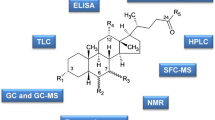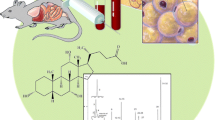Abstract
A newly developed enzymatic method for determining urinary 3α-sulfated bile acids was used to measure serum 3α-sulfated bile acid levels in 114 patients with hepatobiliary diseases and 56 healthy subjects. The lowest measurable amount of the 3α-sulfated bile acids was 0.5 µmol/liter. The standard curves for glycolithocholic acid 3α-sulfate, glycoursodeoxycholic acid 3α-sulfate, and lithocholic acid 3α-sulfate were linear from 0.5 to 250 µmol/liter. Specificity of the assay was satisfactory and intra- and interassay variations ranged from 0.8 to 4.4% and from 1.2 to 7.9%, respectively. Analytical recovery was more than 91%. The values obtained by this assay were well correlated with those by gas-liquid chromatography measurement (r=0.91,P<0.01). The fasting serum 3α-sulfated bile acids level in healthy subjects ranged from undetectable to 1.9 µmol/liter (mean±se; 0.9±0.1 µmol/liter). The percentage of 3α-sulfated bile acids in total bile acids (sum of 3α-sulfated and 3α-hydroxy bile acids) in serum was 16.8±1.5%. In subjects with hepatobiliary diseases, serum 3α-sulfated bile acids levels were elevated; however, the percentage of 3α-sulfated bile acids in total bile acids was decreased and correlated with the severity of hepatocellular insufficiency. This enzymatic assay is simple, rapid, and accurate for the determination of serum 3α-sulfated bile acids.
Similar content being viewed by others
References
Erlinger S: Physiology of bile secretion and enterohepatic circulation.In Physiology of the Gastrointestinal Tract. LR Johnson (ed). New York, Raven Press, 1987, pp 1557–1580
Mashige F, Imai K, Osuga T: A simple and sensitive assay of total serum bile acids. Clin Chim Acta 70:79–86, 1976
Makino I, Hashimoto H, Shinozaki K: Sulfated and nonsulfated bile acids in urine, serum and bile of patients with hepatobiliary diseases. Gastroenterology 68:545–553, 1975
Hirano Y, Miyazaki H, Higashidate S: Analysis of 3-sulfated and nonsulfated bile acids by one-step solvolysis and high performance liquid chromtography. J Lipid Res 28:1524–1529, 1987
Sethell KDR, Balistreri WF, Lin Q, Watson D, Yamashita H: Metabolism of ursodeoxycholic acid in normal subjects and in patients with cholestatic liver disease: Biotransformation by conjugation and urinary excretion.In Bile Acids and Hepatobiliary System. G Paumgartner, W Gerok (eds). Dordrecht, Kluwer Academic Publishers, 1993, pp 245–249
Bartholomew TC, Summerfield JA, Billing BH, Lawson AM, Setchell KD: Bile acid profiles of human serum and skin interstitial fluid and their relationship to pruritus studied by gas chromatography-mass spectrometry. Clin Sci 63:65–73, 1982
Tazuke Y, Matsuda K, Okada S: A novel sulfatase fromPseudomonas testosteroni hydrolyzing lithocholic acid sulfate. Biosci Biotech Biochem 56:1584–1588, 1992
Tazuke Y, Matsuda K, Adachi K: Purification and properties of bile acid sulfate sulfatase fromPseudomonas testosteroni. Biosci Biotech Biochem 58:889–894, 1994
Tazuke Y, Kodama N, Adachi K: A new enzymatic assay method of sulfated bile acids in urine. Jpn J Clin Chem 21:249–258, 1992
Setchell KD, Worthington J: A rapid method for the quantitative extraction of bile acids and their conjugates from serum using commercially available reverse-phase octadecylsilane bonded silica cartridges. Clin Chim Acta 125:135–144, 1982
Simmonds WJ, Korman MG, Go VLW, Hofmann AF: Radioimmunoassay of conjugated cholyl bile acids in serum. Gastroenterology 65:705–711, 1973
Setchell KDR, Matsui A: Serum bile acid analysis. Clin Chim Acta 127:1–17, 1983
Eyssen HJ, Parmentier GG, Mertens JA: Sulfated bile acids in germ-free and conventional mice. Eur J Biochem 66:507–514, 1976
Nair PP, Gordon M, Bebach J: The enzymic cleavage of the carbon-nitrogen bond in 3α, 7α, 12α-trihydroxy-5β-cholan-24-oylglycine. J Biol Chem: 242:7–11, 1967
Nakamura K, Yoneda M, Kimura A, Tamori K, Yokohama S, Sato Y, Kato K, Hasegawa T, Saito H, Aoshima M, Fujita M, Makino I: Increase of sulfated ursodeoxycholic acid in the serum and urine of patients with chronic liver disease after ursodeoxycholic acid therapy. J Gastroenterol Hepatol 11:385–390, 1996
Palmer RH: The formation of bile acid sulfates: A new pathway of bile acid metabolism in humans. Pro Natl Acad Sci USA 58:1047–1050, 1967
Stiehl A, Earnest D, Admirand WH: Sulfation and renal excretion of bile salts in patients with cirrhosis of the liver. Gastroenterology 68:534–544, 1975
Summerfield JA, Cullen J, Barnes S: Evidence for renal control of urinary excretion of bile acids and bile acid sulphate in the cholestatic syndrome. Clin Sci Mol Med 52:51–65, 1977
Bremmelgaard A, Sjövall J: Bile acid Profiles in urine of patients with liver diseases. Europ J Clin Invest 9:341–348, 1979
Takikawa H, Otsuka H, Beppu T: Serum concentrations of bile acid glucuronides in hepatobiliary diseases. Digestion 27:189–195, 1983
Alme B, Bremmelgaard A, Sjövall J: Analysis of metabolic profiles of bile acids in urine using a lipophilic anion exchanger and computerized gas-liquid chromatography-mass spectrometry. J Lipid Res 18:339–362, 1977
Sethell KDR, Lawson AM, Blackstock EJ, Murphy GM: Diurnal changes in serum unconjugated bile acids in normal man. Gut 23:637–642, 1982
Takikawa H, Beppu T, Seyama Y, Sugomoto T: Glucronidated and sulfated bile acids in serum of patients with acute hepatitis. Dig Dis Sci 31:487–491, 1986
Murata N, Beppu T, Takikawa H, Otsuka H, Kasama T, Seyama Y: Determination of sulfated and nonsulfated bile acids in serum by mass fragmentography. Steroids 42:575–592, 1983
Campbell CB, MaGuffie C, Powell LW: The measurement of sulphated and non-sulphated bile acids in serum using gas-liquid chromatography. Clin Chim Acta 63:249–262, 1975
Lööf L, Wengle B: Enzymatic sulfation of bile salts in human liver. Biochim Biophys Acta 50:451–460, 1978
Summerfield JA, Gollan JL, Billing BH: Synthesis of bile acid monosulfates by the isolated perfused rat kidney. Biochem J 156:339–345, 1976
Author information
Authors and Affiliations
Rights and permissions
About this article
Cite this article
Kato, T., Yoneda, M., Nakamura, K. et al. Enzymatic determination of serum 3α-sulfated bile acids concentration with bile acid 3α-sulfate sulfohydrolase. Digest Dis Sci 41, 1564–1570 (1996). https://doi.org/10.1007/BF02087901
Received:
Revised:
Accepted:
Issue Date:
DOI: https://doi.org/10.1007/BF02087901




